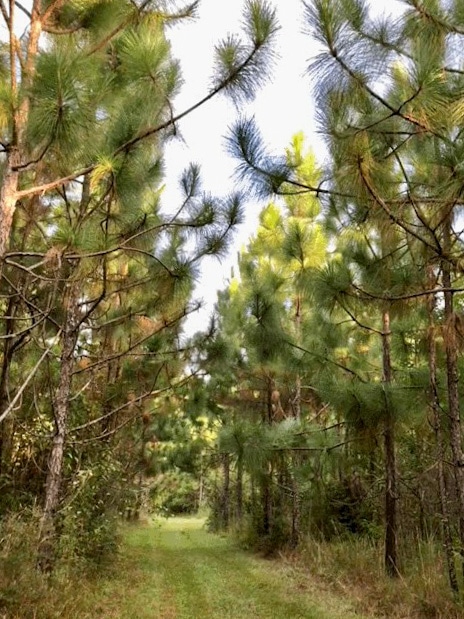Beryl Trawick started learning about legacy at a young age. Her grandmother loved everything about the natural world… especially the animals, plants, and forests on their family farm in Tangipahoa Parish. Following her grandmother’s example, Beryl developed her own love for the land and her native forests. This passion eventually drove her to enter the family property in the U.S. Forest Legacy Program, after many years spent learning about the importance of longleaf pine to Louisiana and the Southeast.

Longleaf savanna used to cover the southeastern coastal plain, from Virginia all the way to Texas. The pines are now endangered thanks to heavy development and clearing for timber. “This area north of Lake Pontchartrain used to be covered in longleaf,” says Beryl, talking about her family’s connection to the tree. “Our farm has a 120 year old house that was built with longleaf. It helped to build this land.”
The explosion of development on the Northshore has been partly driven by people looking for a place to build post-Katrina, which has ironically weakened the area’s ability to withstand storms. Longleaf is more storm resistant than other pine species, and in fact, it was hurricanes like Katrina which showed that longleaf is 30-40% more likely to survive storms than other pines.
Beryl says that it was a beetle infestation that sparked her passion for longleaf. In the 1990s pine bark beetles started threatening longleaf stands in Tangipahoa, and the solution was to cut away circles of trees in order to stop the spread. This stopped the beetles, and Beryl wanted to replant the circles that had been cut away on the family property. At the time, it was considered primarily an upland tree that couldn’t thrive in the swampy coastal zone, but she knew it grew.

“If it hadn’t been for the pine bark beetle I don’t know if I would have jumped on it…” but jump on it she did. Beryl’s experience reforesting her family land led to attending seminars with the newly-formed Longleaf Alliance, and she served on their board for three years. She traveled across the south learning about the longleaf ecosystem, and saw her own forest change with the maintenance of healthy trees – like the introduction of native grasses, the Northern bobwhite, and wild turkeys.
The destruction of Katrina, and the post-storm development on the Northshore, helped to change many minds about longleaf. Seeing how storm-resilient the trees were led to a lot more interest in protecting our region’s native forests. Beryl credits then-Louisiana State Forester, Paul Frey, with getting the Florida Parishes eligible for entry in the Forest Legacy Program. He saw the Northshore giving way to development, and realized that the program was a way to potentially save some of the forests that serve the vital purpose of slowing down and buffering storms.
It’s a long process… Beryl first entered her land for consideration with the U.S. Forest Service in 2007 and didn’t get anywhere. But as the Northshore continued to attract attention as the fastest-growing part of the state, the current Louisiana Agriculture and Forestry administration remained key to moving the project forward. Wheels started turning, and forestry agents eventually came to look at her property – 640 acres owned by Beryl’s family since the 1800s. Finally her application was approved, and now the land will be surveyed and formally entered in the Forest Legacy Program later this year.
Beryl inherited her protective instinct for the natural land from her grandmother, and she hopes to pass it on to the next generation. She says that she would love to work with local schools to introduce students to the land and the importance of preserving our environment.

“My circumstances gave me the opportunity to protect it, and that’s what set me on my path,” says Beryl, reflecting on her journey. “It’s been a joy to see it come back. Once everything fell into place, parts of the ecosystem like animals and native grasses returned quickly. The forest takes a while, but it is rising again.”
Beryl’s accomplishments with her family property are a reminder that with passion and a love for the land, we can all see big change happen in our lifetimes. Since Katrina, Louisiana has suffered from more damaging storms… and climate change is an ever-present threat to the place we call home. But just by acting to protect the places we love, we can have an impact that reaches far beyond property borders.

“I hope that my legacy will be a longleaf forest, left intact forever,” says Beryl. “E.O. Wilson (a Pulitzer-winning biologist from Alabama) said that the best thing to do to slow global warming is to plant a longleaf pine tree. I’ve now planted hundreds of thousands and can die happy. The forest will be all right. Yes, it will lose some trees… but we won’t lose them all.”
Land Trust for Louisiana is involved with protecting longleaf pine savannas on many of our conservation properties, like Abita Creek Flatwoods Preserve (in partnership with The Nature Conservancy), Pine Knoll Farm, Cane Bayou Mitigation Bank, and more. Contact us today to learn more about what you can do to support these efforts or place your own property in conservation. Sign up for our Newsletter for more in Louisiana conservation news!


